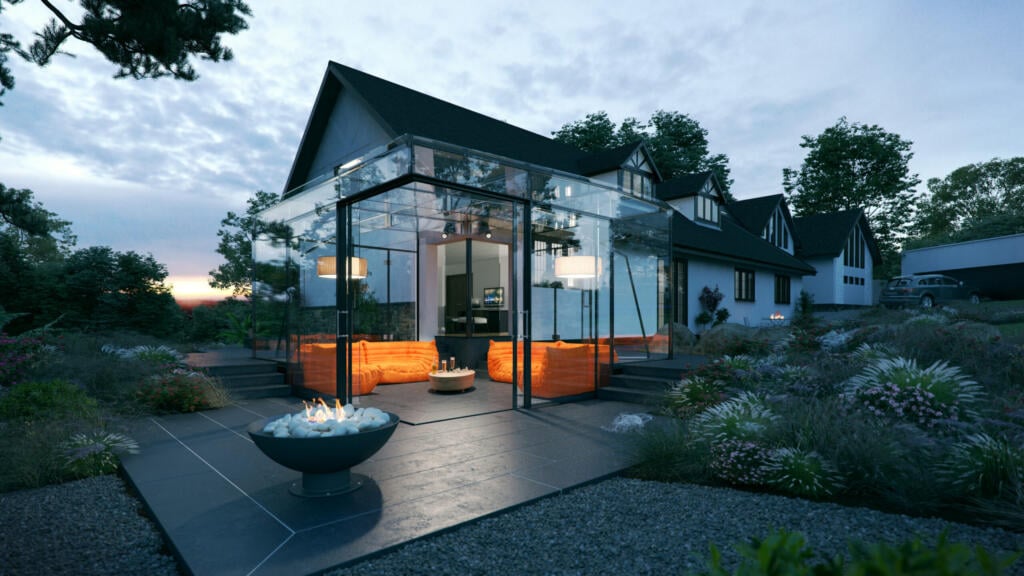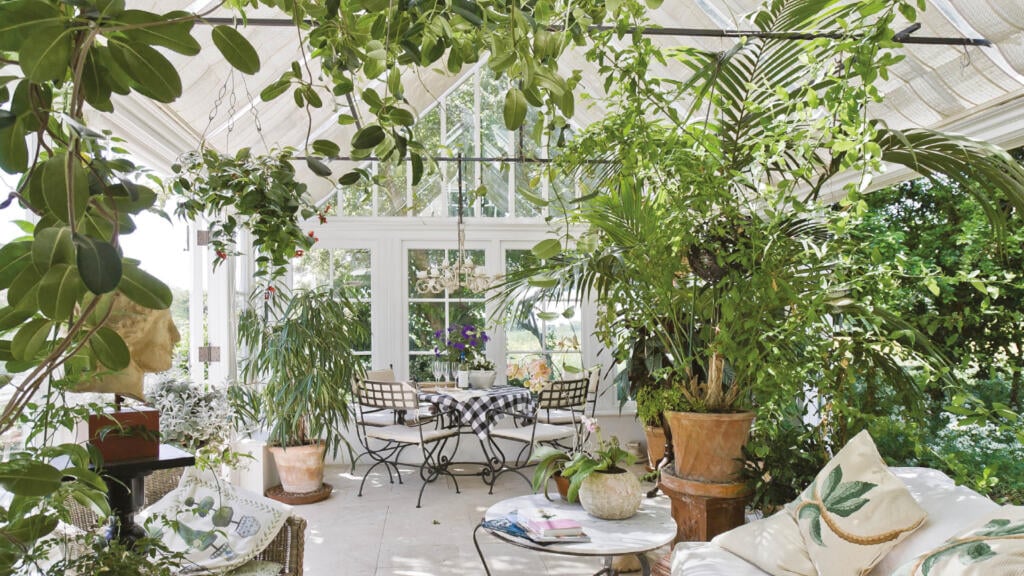
Planning permission: what is it and do I need it?
Sarah Harley
Thinking of adding a new sunny spot this summer but unsure what’s legal or not? Here’s what you need to know
Once a regular suburban sight, white uPVC conservatories were sold to thousands of homeowners as the perfect extension that didn’t require planning permission.
Many of us thought conservatories fell under different planning rules to other residential works – but they don’t.
Once a regular suburban sight, white uPVC conservatories were sold to thousands of homeowners as the perfect extension that didn’t require planning permission.
Many of us thought conservatories fell under different planning rules to other residential works – but they don’t.
 Credit: Hampton Conservatories
Credit: Hampton ConservatoriesConservatories in the UK (except Scotland, where some exceptions apply) are covered by the same set of rules as any type of extension to your home. These are known as permitted development rights.
In basic terms, a conservatory is typically defined as a room with at least 75% of the roof and 35% of the external walls made from translucent material and separated from the main building by a door.
While this may still hold true for some conservatories, in many cases the growth in architectural design means anything from a contemporary glass box to an opulent orangery is now loosely termed as a conservatory.
 Credit: GlasSpace
Credit: GlasSpaceAs a result, when it comes to your local authority deciding if it needs planning approval, it’s more about size, positioning and how the space is accessed from the original property.
We asked Sandra Richardson, planning applications team manager at Luton Borough Council, why she thinks there has historically been confusion about conservatories being exempt from planning.
“It’s always been the case that conservatories were considered in the same way as extensions, so I think some of the confusion has come from the difference regarding the need for building control approval,” says Richardson.
“We know from speaking to homeowners that a lot of companies used to say to them that as long as the conservatory was small enough, they didn’t need building regulation approval.
“Although this is partly true, they then wouldn’t go on to talk about planning, leaving homeowners convinced there was no planning required. Thankfully, a lot of companies nowadays are a lot savvier, and people are clearer about what’s involved.”
But, when there are legal implications for building without the correct permission, getting it right is key to avoid hefty fines or being asked to remove your conservatory completely.
Across the UK, conservatories and extensions are assessed under a category known as permitted development rights. In simple terms, this affords an amount of ‘permitted development’ to every property – meaning if you fall within the guidelines, you don’t always need to apply for full planning consent.
But there are a number of caveats.
If you live in a flat, maisonette or listed building, you are excluded from permitted development rights. Living in a conservation area also makes it more likely there will be additional restrictions imposed.
If you live in a new build home, it’s also worth checking your contract, as some developers have conditions regarding extending or adding to your house.
 Credit: Shutterstock/NKLato
Credit: Shutterstock/NKLatoRichardson says modern conservatory designs with additional architectural features can also catch people off-guard.
“It’s key that people understand there are still design restrictions with permitted development rights they may not be aware of.
“You see a lot of adverts with modern designs that may well fall into permitted development rights when it comes to size and positioning, but as soon as you add extra architectural features such as verandas, then you will absolutely need to get planning permission.”
Even if none of these caveats apply, there are still specific conditions that dictate whether your conservatory or extension falls under permitted development rights.
In general, every house will sit within its own boundaries. This is also known as the curtilage.
Planning laws state that the total area of additional building works within the curtilage – excluding the footprint of the original dwelling – cannot be more than 50% of the total curtilage.
As an example, if you had 10 square metres of land left available within your curtilage, you couldn’t add a conservatory that is six square metres in size, but you may be able to add one that is five square metres.
 Credit: Shutterstock/Bself
Credit: Shutterstock/BselfScotland has some variations to the rest of the UK
Scottish rules also specify that any conservatory or extension above eight square metres cannot cover more ground area than the existing house. There is also a 16 square metres (or 10% of total floor area of property) rule in place for conservatories or extensions added to terraced or semi-detached houses and a maximum 24 square metres (or 20% of total floor space) for detached houses.
The amount of additional space you can add depends on the size of your ‘original’ dwelling. This is defined as the date when it was constructed, or if you live in an older property, how it stood on July 1 1948.
This means unless you bought your house from new or are aware of every building project that has taken place since it was built, there’s a chance your property may have already been extended to the maximum amount allowed.
 Credit: Shutterstock/Romdo Tavani
Credit: Shutterstock/Romdo TavaniHow do you find out? Contact your local authority planning officer and ask them to check the records. If they say you are past your quota, you will need to apply for homeowner planning consent – regardless of the style or size of your design.
Richardson notes how, in the first instance, a lot of the information is now available online. There may be some charges involved but, when it comes to fact-checking, Richardson says this is her absolute top tip before you commit to a new conservatory.
If you get the green light to proceed, there are more rules to be aware of.
The eaves of a house are defined as the point where the external walls meet the lowest point of the upper surface of the roof. Any conservatory cannot be higher than the highest part of the existing roof, and the eaves of the conservatory cannot be higher than the existing eaves.
In addition to this, the overall height cannot exceed four metres and if the distance from the edge of your proposed project falls within two metres of your boundary, the height permitted is reduced to three metres.
Permitted development rights mainly apply to works that take place to the rear of your property. If you are looking to add to the front or side of your house, additional restrictions apply.
Works that take place to the front or side of your property cannot go past the front of your principal elevation – this is classed as the side of your property that faces the highway.
 Credit: Hampton Conservatories
Credit: Hampton ConservatoriesFor clarity, a highway doesn’t just mean a street or a main road. A highway is defined as any pathway over which the public have the right to pass, including public roads, carriageways, footways, footpaths, bridleways and cycleways.
A side conservatory must also be less than 50% of the width of the original house.
Additional guidelines for Wales and Northern Ireland
If you live in Wales, side conservatories have additional restrictions on size in conservation areas, national parks, Areas of Outstanding Natural Beauty or World Heritage Sites.
In Northern Ireland, a side conservatory can be no longer than four metres and no part of the new addition can be within three and a half metres of any property boundary with a road opposite the rear wall of the house.
Choosing similar materials to your original home may help when it comes to the permitted development rights category. Don’t assume that because conservatories have always been made from different materials, this guidance doesn’t matter.
Richardson advises it’s still worth asking your local planning officer for guidance.
 Credit: Shutterstock/ME Image
Credit: Shutterstock/ME Image“If you’re thinking of choosing a more modern conservatory, it’s still worth getting this checked by the local authority,” she says.
“While traditional conservatories maybe didn’t completely match, the white uPVC frame often tied in with window frames and dwarf walls tended to be finished with a similar brick stock or render as the main house.
“But with conservatory design having undergone radical changes, the contrast can now be even greater. If you’re thinking of using something that’s contemporary, you probably want to get that checked out to make sure you’re not doing anything that’s going to cause you a problem afterwards.”
Although the thought of a sunny room that wraps around the house may be tempting, the sheer scale of this addition makes it unlikely to fall under permitted development rights, unless you have never extended before and have a larger plot of land.
Ensure you have your facts established before you even consider contacting a conservatory supplier.
Find out whether you already have restrictions on your property – such as living in a conservation area – that may make the right to permitted development rights less of an option
Make sure you use a well-established conservatory company and ask them how knowledgeable they are about permitted development rights.
Always make sure you act-check anything you are told with your local planning officer before you proceed.
Although your conservatory may fall under permitted development rights for planning, you might still need building regulations approval.
In England, Wales and Northern Ireland, a conservatory is normally exempt from building regulations as long as:
A word of advice – do not place your conservatory where it may restrict ladder access to windows serving rooms in the roof or loft conversions, as this will not be approved.
If you have to create a structural opening between the existing house and conservatory, then even if the conservatory is exempt, you will also need building regulations approval to create the new doorway to ensure your home still complies with fire regulations.
Additional requirements in Northern Ireland mean that conservatories must have at least 75% of the roof and 50% of the walls made of translucent material. If you want to install any type of heating to your conservatory, this will mean it needs building regulations approval.
 Credit: Thomas Sanderson
Credit: Thomas SandersonAlthough Scotland follows similar rules to the rest of the UK when it comes to getting approval, there are additional requirements listed on the Scottish government website.
For further information on permitted development rights in each individual nation, details can be found here.
Permitted development rights in England
Permitted development rights in Wales
If you are already speaking to reputable conservatory companies, many of the larger ones will initially be able to offer advice regarding what is and isn’t permitted.
However, we would also always recommend you contact your local authority planning and building regulations departments for total clarity. Well versed in dealing with enquiries of this nature, they will also be able to check if your house has previously been extended.
To be absolutely sure, you can also apply to your local authority for a document that confirms that at the time of building, your conservatory was lawful.
In England and Wales this is known as a Lawful Development Certificate, in Scotland a Certificate of Lawfulness and in Northern Ireland a Certificate of Lawful Use or Development. In all cases this has a fee attached and can take eight weeks to be issued.
 Credit: Shutterstock/Little Red Dragon
Credit: Shutterstock/Little Red DragonRichardson explains the value in obtaining one.
“The problem with having a conservatory that requires no planning permission or building regulations approval, is that when you come to sell your house, solicitors and buyers are generally asking for proof of approval – regardless of what you tell them.
“If you don’t have any documentation to back your claims, you can face additional delays selling your house while you apply for one retrospectively.
“Plus, if you lose the document, we always have a copy of it,” she adds. “It’s something we always recommend if people write to us and ask permitted development questions. Having one makes your home future proof.”
Some councils, such as Luton, offer a fast-track service for this, but we recommend you check with your local planning authority to confirm their individual timelines on obtaining one.

Written by Sarah Harley she/her
Published:
Since first picking up a paintbrush and experiencing the joy of re-decorating her bedroom in a questionable red, white and grey scheme as a young teenager, Sarah Harley was hooked on the world of interior design. This obsession even led to a real life ‘Grand Designs’ project in 2005 when she donned a pink hard hat and appeared on TV screens, project managing the renovation and extension of a Grade II listed 17th century Folly in South Wales.
Throughout her career, Sarah has gained an array of experience in several different roles, ranging from copywriting, PR, events management and photography to interior design and home staging. With her two passions being the written word and the joys of a beautifully designed home, Sarah’s mission is to open the door on the world of interiors, inviting readers in to help them work their way through the vast choice of products, ideas and trends so that their own homes can reach their full potential.

Sarah Harley

Sarah Harley

Sarah Harley

Sarah Harley